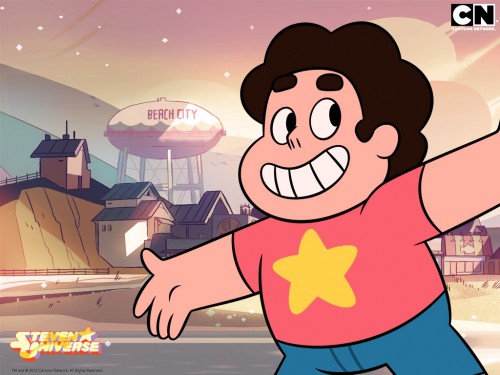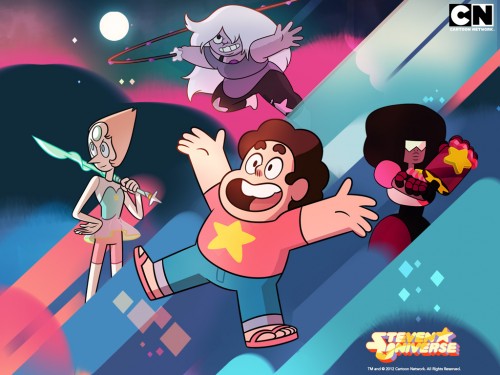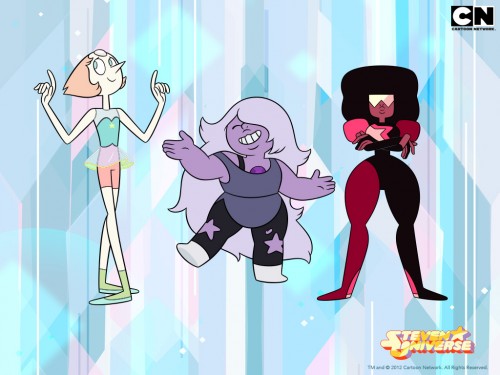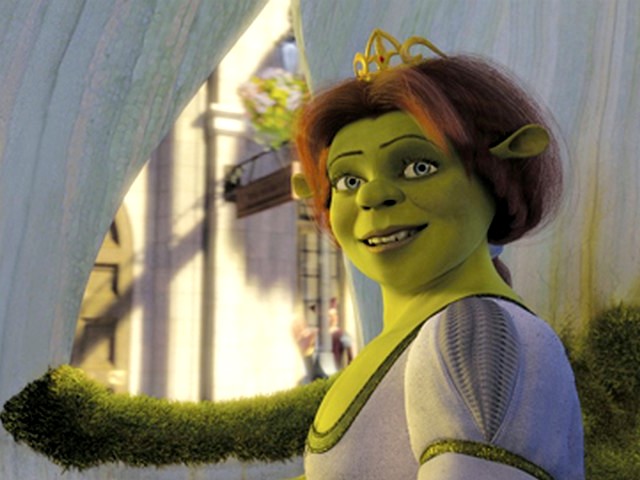
This guest post by Megan Wright appears as part of our theme week on Children’s Television.
In the past years, with all the superhero movies coming out, it’s no surprise that children’s shows would become especially interested in making TV shows to capitalize on the trend. Granted, Saturday morning cartoons have always featured some superheroes, but there have been a great deal of superhero shows coming out lately: Avengers Assemble, Ultimate Spider-Man, and Hulk and the Agents of S.M.A.S.H.!, are just a few examples. But Steven Universe, a show that revolves around a young superhero in the making, is one of the best – and most progressive – examples on television.
Steven is a young boy who gets his superpowers from his powerful gem passed on to him from his mother, who died after giving up her gem. Since his birth, Steven has lived with his mother’s former teammates, the Crystal Gems, who raise Steven and help train him to become a Crystal Gem.
Steven Universe embraces non-traditional families. Steven is a perfectly happy kid, who is raised by three women who love him. The Gems are wonderful guardians for Steven, acting as mothers, sisters, and leaders to him. Even though the Gems and Steven don’t always see eye to eye, they always try to step beyond their comfort zones for one another. The Gems may not understand the concept of video games, but if Steven wants to go to an arcade, then they’ll go. If Steven wants to throw them several birthdays for the thousands of ones they haven’t celebrated, they’ll let him dress like a clown and play party games with them, because even though they don’t understand it, it clearly means a lot to Steven.
Steven also has a good relationship with his father, who doesn’t live with the Gems, but rather in his van. Greg Universe may not always understand the Gems and vice versa, but they get along for Steven’s sake. And even though Steven’s superpowers make Greg nervous, he’ll try to understand and help his son with them. The series makes it clear that one of the reasons Steven is such a carefree and sweet child is that he was raised in a positive environment, with four adult figures who clearly care and love him. His ideas, even if they don’t always work, are praised; his enthusiasm for everything encouraged. Even when his superpowers don’t work, the Gems always try to help him get better as a hero.

Most superhero shows have mainly male superheroes as either the focus of the show, or the majority of the team. It’s interesting to see a show that revolves mainly around women with superpowers. Due to his young age, Steven’s powers are inconsistent, so most of the monsters that the Gems battle are defeated by his teammates: Garnet, Amethyst, and Pearl. These characters each come equipped with their own special gems, weapons, and superpowers, making them the strength behind the superhero show.
One of the best things about the Gems is how different they are from one another, both in personality and body type. Everything about these characters differs physically: hair, weight, height, superoutfits, etc. Young girls watching this show can probably identify with Amethyst’s outfit of jeans and a shirt, Pearl’s skirt and tights, or Garnet’s shades than they can with Black Widow’s catsuit. It also passes on the message that you don’t have to look a certain way to be a superhero. For girls who constantly have to see huge breasts, skin-tight costumes, and somehow impeccably styled hair if they want to see a female superhero, this show has to be a relief.
Even better is the fact that the Gems all have their own personalities, which go much deeper than most kid shows’ characters. Pearl is orderly and the most cautious of the Gems, but it’s mainly the result of trying to protect Steven on missions. It also doesn’t take away from her abilities as a superhero – she doesn’t shy away from violence and is a master swordswoman.
Meanwhile, Amethyst is much more disorderly and has a lax personality about most things, which leads her to clash with the other Gems. This is explored in “Tiger Millionaire,” an episode where it’s discovered that Amethyst has been participating in underground wrestling in order to get out all her energy and frustration with the other Gems. By the end of the episode, Pearl and Garnet understand Amethyst’s frustration, and support her wrestling.
Garnet is the team leader, a quiet and stoic personality who commands the Gems and keeps them in line. She’s frequently seen going off on missions of her own, and she is the most powerful of the Gems. Her cool head helps keep Steven safe, and keeps Pearl and Amethyst from bickering all the time.

The series empathizes teamwork between women rather than fighting. While Amethyst and Pearl might not always get along, the show makes it clear that they are still close teammates. In “Giant Woman,” it’s revealed that Pearl and Amethyst can form together to make Opal, a single being who is a powerful combination of their personalities, weapons, and skills. Unfortunately, because their attitudes clash most of the time, they have a hard time forming her. It’s only when they put their bickering aside that they can become Opal, which gives them an advantage in battle. Opal allows them to crush enemies that they would have been stumped by otherwise. The show empathizes that when women work together, they are more powerful.
I’m a feminist and a superhero fan, and sometimes those two loves conflict. I adore superhero comics, movies, and television shows, but I still have to acknowledge they have their problems. Most women are dressed in skin-tight outfits or barely any clothes at all, women are still in the minority numbers on teams, and there still hasn’t been a movie released yet that has a female as the main superhero.
What Steven Universe gives me is a show that offers a distinctively different take on female superheroes – they’re the most powerful beings on the show, they wear outfits that actually look useful for fighting crime in, and the show allows them to show their inner personalities as well as kick ass. I’m so excited that there’s a show out there like this for young girls: one that reinforces positive cooperation between women, that allows their female characters to have each have their own body types and personalities, and lets them see strong females that don’t apologize for their power.
Megan Wright is a TV reviewer for Gotta Watch It. This is her second time as a guest writer for Bitch Flicks.




